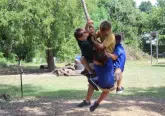Why ‘disappointing’ Census numbers are such a concern
by Matt Hadro
Washington D.C., Apr 30, 2021 / 04:00 am America/Denver (CNA).
New Census numbers show the U.S. had its slowest decade of population growth since the Great Depression – and experts say this confirms a pre-existing downward trend.
On Monday, the U.S. Census Bureau released its decennial count of population and housing. Data revealed that the U.S. population growth in the past decade was the slowest in nearly a century.
Demographic experts told CNA that the Census numbers were possibly worse than the already-muted expectations for population growth.
“We’ve known for quite a while that this Census was going to show a relatively low growth rate. It ultimately showed an even lower one than we expected, so it’s sort of a pessimistic indicator overall – that is, things are worse than we thought,” said Lyman Stone, research fellow at the Institute for Family Studies.
With warnings swirling of a “baby bust” – a sharp decline in the birth rate due to the pandemic and its economic consequences – the Census numbers are “like a nail in the coffin,” said Catherine Ruth Pakaluk, director of social research and assistant professor at the Catholic University of America’s Busch School of Business.
“We’re seeing the [birth rate] trend, the trend was already downward,” she said.
A long-term decline in the birth rate reaches back to the 19th century, Pakaluk noted. While certain demographics, such as immigrant populations, might have higher birth rates than others, eventually all demographics converge on a fertility rate decline in the United States.
“As society has gotten wealthier, we’re seeing fewer and fewer children born. And so what exactly is explaining that?” she asked, noting that a post-World War II “baby boom” was an anomaly in the 20th century.
While birth rates normally fall during a recession, they are not rising afterward, she said, noting that birth rates did not go up in the past decade after the “Great Recession.” This fact, she said, “tells you something else is going on.”
A continued decline in the birth rates could pose some far-reaching negative social consequences.
Schools could be among the hardest-hit by a population decline, with lower enrollment, reduced funding, and possibly the closure of many educational institutions, Stone said.
As the younger generation reaches working age, there might be fewer workers available, labor shortages, slower economic growth, and less entrepreneurship, he said.
The “strain on state budgets” is “where you’re going to start to see this kind of playing itself out,” Pakaluk said of negative social consequences of a decline in the birth rate.
Recent education cuts in Ohio are an example of this tension between states meeting commitments to seniors, such as through pensions, while trying to invest in the youth through education, she said. If fewer taxpayers are paying for senior benefits, budget cuts will have to come from somewhere.
“You’d think this’d be a time when states want to really ramp it [education spending] up a little bit,” she said. “But that kind of a trade-off – those are the kinds of really unpleasant tradeoffs between, let’s just say the young and the old, that become both immanent and also very unpleasant in light of an aging population.”













